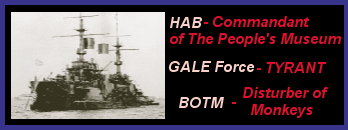I think that the GCS really represented the whole cultural problem the 24th Century Federation started to suffer from after the peace treaty with the Klingons. The whole ship looks like it was designed by people who seriously expected the simple fact that it was a
Federation ship would send any prospective bad guy packing. It has huge surfaces to act as aiming points from several angles. Although space manouevrability isn't always tied to size, the thing always struck me as likely having a turning circle like a 200,000t cow.
On the flip side, despite the well-known design problems with the first-generation GCS warp core, the ship was pretty tough and managed to take quite a few hits in several battles without suffering serious system failures (contrast with the Intrepid-class' tendancy to lose large parts of its' systems from one hit to the shields).
What would I have done differently?
- The longest axis of the saucer should have been fore-aft rather than from side to side.
- Extend the nacelles and make them narrower, more like the SCS nacelles
- The pylon-side phaser banks should have extended to curve around the front edge of the nacelle pylons, adding two more forward-firing phaser banks.
- Independent warp drive for the Saucer. Why have a huge lifeboat for your non-combatant personnel that is restricted to sub-light speeds?
- Secondary pulse phaser banks (about the same power output as the BoP's main disruptors) designed for CIWS and independent fire against multiple small targets
In the end, the GCS was a long-haul explorer that (during the Dominion War) got retrofitted into becomming a battlecruiser, a role that its' design simply didn't support.
The Sovereign-class represents the result of applying all the hard-won lessons about capital starships learnt during the Enterprise-D's 8-year lifespan. It has much more flexible and powerful weapon systems. It maintains a great deal of function, even when its' internal security has been compromised (in ST:FC, the auto-destruct worked even with about 3/4 of the ship under enemy control, contrast with how easily the Voyager's scuttle system could be compromised). It has a lot more sub-light agility, a lot more system redundancy (maintaining full combat capability, even without its' warp core).
On the flip side, however, a lot of the same basic conceptual problems of post-Klingon War-era Federation starships still exist. The design is over-centralised (a single fire control station in a threat-rich environment is a disadvantage, even the little Defiant had independent 'port' and 'starboard' fire-control stations according to the TM). The design is still a rat-warren of access shafts and cable trunks that an intruder could use to move around the ship semi-undetected. Overall, however, it looks a lot better than the older GCS.
What would I have done differently?
- Three axial ship-killer superphaser cannon (see 'All Good Things'), one co-axial with the quantum torpedo launcher, one firing through the very front of the saucer and one co-axial with the aft quantum torpedo launcher (see below)
- An aft quantum torpedo launcher turret, like the one on the bottom of the saucer, below the landing bay fantail
- Return of the medium-power CIWS phaser banks
- Use that strange trench mid-way in around the bottom surface of the saucer as "drop-out" fighter hangers.
- Three more impulse engines (two on the ends of the nacelles, one above the after photon torpedo launcher)
Nothing much... Just upgrade it to dreadnought-level power...

Overall? I would say that the SCS is the better looking of the two ships (although some of the 'beauty shots' from Generations made the Ent-D look better than it ever had in the series). In the end, the Galaxy-class was crippled by the fact it was designed to represent a
philosophy (mostly Mr. Roddenberry's idea of a perfect society) rather than look good or half-way sensible. That was its' crippling fault.
[EDIT - Added SCS wish list]


